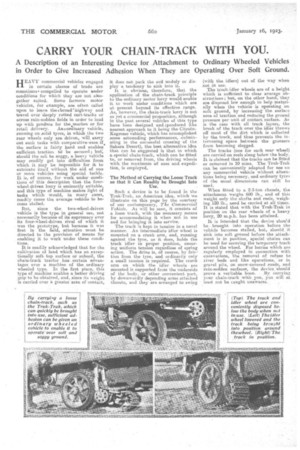CARRY YOUR CHAIN-TRACK WITH YOU.
Page 14

If you've noticed an error in this article please click here to report it so we can fix it.
A Description of an Interesting Device for Attachment to Ordinary Wheeled Vehicles in Order to Give Increased Adhesion When They are Operating Over Soft Ground.
HEAVY commercial vehicles engaged 1.1in certain classes of trade are sometimes compelled to operate wider conditions for which they are not altogether suited. Some farmers motor vehicles, for example, are often called upon to leave thetbroad'ibighway and travel over 'deeply rutted cart-tracks or across rain-sudden fields in order to load up with produce for the marl or for retail delivery. Anoordinary vehicle, running on .solid tyres, in which the two rear wheels only are driven, will carry out such tasks with comparativerease if, the surface is fairly hard and enables
° sufficient. traction, td be secured; but; should the soil be soggy, a heavy vehicle may readily get into difficulties from which it may be impossible for it to extricate itself without the aid of one or more vehicles using 'special tackle. is, of course, for work under conditions of this description thai the fourwheel-driven lorry is eminently suitable, and this type of machine makes light of tasks which' would, in many cases, readily cause the average vehicle to become stalled.
But, since the two-wheel-driven vehicle is the type in general use, not necessarily because of its supremacy over its four-wheel-driven rival of which it was the prototype, but because it was first in the field, attention must be. directed to the provision of means for enabling it to work under these conditions.
It is readily acknowledged that for the cultivation of land which has an exceptionally soft top surface or 'subsoil, the sham-track tractor has, certain advantages over a machine of the ordinary wheeled typo. In the first place, this type of machine enables a better driving grip to be obtained, and, since its a-eight is carried over 4 greater area of contact, it does not pack the E0131 unduly or display a tendency to sink into it.
It is obvious, therefore, that the application of the chain-track principle to the ordinary motor lorry would enable it to work under conditions which are at present beyond its effective range. As, however, the chain-track lorry is not as yet a commercial proposition, although in the past several vehicles of this type have been designed and ("produced (the nearest approach to it being the CitroenKegresse vehicle, which has accomplished some astounding performances, ,culminating in the successful crossing of the Sahara Desert), the beat alternative idea that can be suggested is that in which a special chain-track, which can be fitted to, or removed from, the driving wheels with the maximum of ease and expedition, is employed.
The Method of Carrying the Loose Track so that it Can Readily be Brought Into Use.
Such a device is to be found in the Truk-Trak, an American idea, which we illustrate on this page by the courtesy of our contemporary, The Commercial Vehicle. As will be seen, it consists of a loose track, with the necessary means for accommodating it when not in use and for bringing it into service.
The track is kept in tension in a novel manner. An intermediate idler wheel is mounted on a crank arm, and, running against the tyre, as it does, holds the track idler in proper position, ensuring uniform tension regardless of spring action, The drive is, of course, by fric-. tion from the tyre, and ordinarily only a small tension is required. The crank arm on which the idler wheels are mounted is supported from the underside of the body, or other convenient part, by downwardly depending arms attached thereto, and they are arranged to swing
(with the idlers) out of the way when not in use.
The track-idler wheels are of a height which is sufficient to clear average obstructions; but, on the other hand,.they are disposed, low enough to help materially when the vehicle is operating on suit ground, by increasing the surface area of traction and reducing the ground pressure per unit of contact, surface. As is the case with all track layers, the break of the track over the idler throws off most of the dirt which is collected by the track, and thus prevents the intervening space between the grousers from becoming clogged.
The tracks (one for each rear wheel) are carried on reels slung below the body. It is claimed that the tracks can be fitted or removed in 10 mins. The Truk-Trak can be conveniently adapted for use on any commercial vehicle without alterations being necessary, and ordinary tyres of the usual dimensions can still be used When fitted to a 2-3-ton chassis, the attacinueut weighs 600 lb., and of this weight only the shafts and reels, weighing 120 lb. need be carried at all times. It is stated that with the Truk-Trak in position on the rear wheels of a heavy lorry, 20 m.p.h. has been attained.
It is intended that the device should be brought into operation before the vehicle becomes stalled, but, should it an-Lk into soft ground before the 'attachment is in position, special -chains can be used for securing the temporary track around the wheel. For lorries which are regularly employed in connection with excavations, the removal of refuse to river beds and like operations, or in gravel pits, on snow-covered roads, and rain-sadden surfaces the device should
prove a veritable boon. .By carrying your chain-track with, you, you will at least not be caught unawares.






























